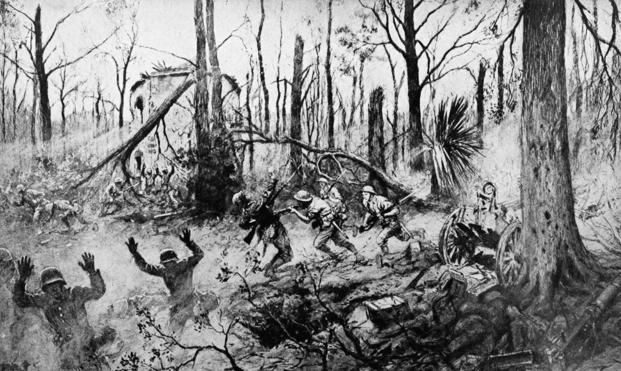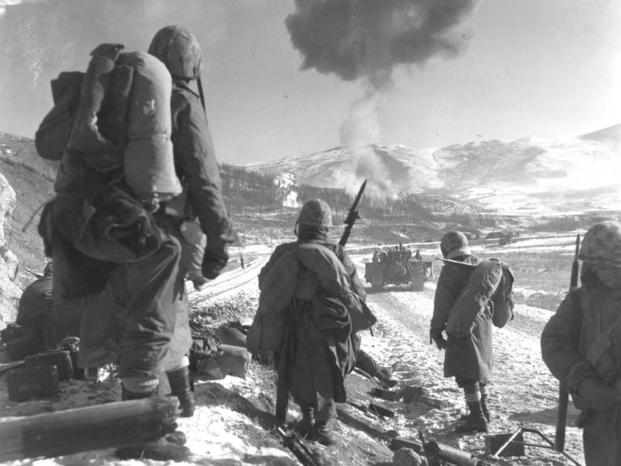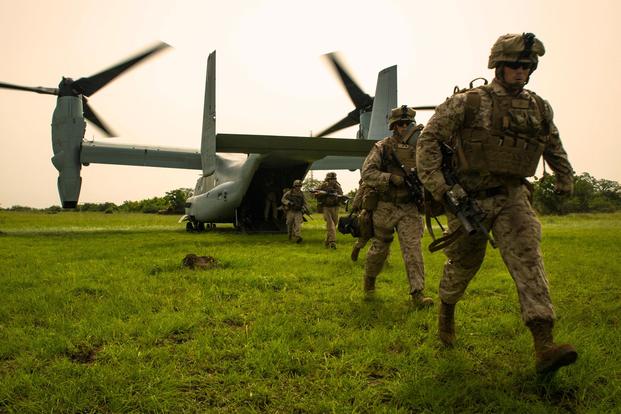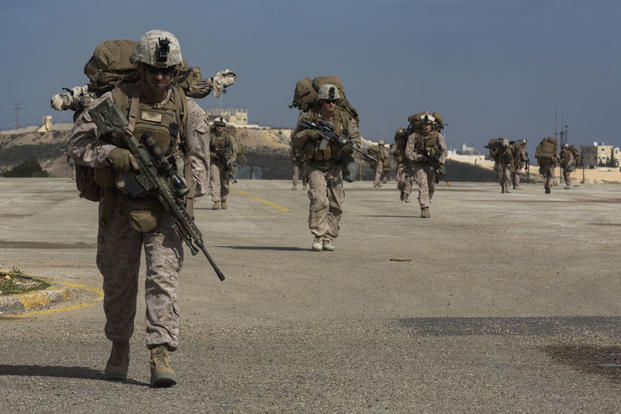Happy birthday to the Marine Corps Reserve! In commemoration of over a century of service, here is some information on the history of the force.
From World War I through the Global War on Terrorism, and for over 100 years, the Marine Corps Reserve has played an essential role in the Marine Corps Total Force.
Dating to the Civil War, civilian and military leaders alike recognized the need for a Naval Reserve, which included detachments of Marines, to augment the fleet during wartime. Prior to World War I, individual states attempted to fill the need through naval militias under state control. The lack of a centralized, national force, however, limited the combat effectiveness and readiness of these units.
Related: 10 Famous Marines (including famous Marine Corps Reservists)
World War I: Birth of The Reserve Force

As U.S. involvement in World War I loomed in 1916, it was decided that the formal creation of an operational Reserve Force was required. On August 29 of that year, President Woodrow Wilson signed the Naval Appropriations Act of 1916, which established the Marine Corps Reserve. The organization would grow rapidly from 35 Marines on April 1, 1916, to a peak of 6,467 (including 300 women) by the time Germany surrendered in November 1918.
During World War I, Reserve Marines fought on sea and on land, including major battles such as Belleau Wood, Soissons, St. Mihiel, and Meusse-Argonne. Reserve Marines also flew with the British Northern Bombing Group, targeting enemy transportation networks. U.S. Marine Lt. Gen. Karl S. Day, a junior officer at the time, spoke highly of the new force: “Nobody gave a damn and few, if any, knew who were regulars, temporaries, duration reserves, what have you.”
By 1922, the entire Marine Reserve had been demobilized to inactive status, with less than 600 Marines in the Reserve Force. Nevertheless, Commandant of the Marine Corps Maj. Gen. John A. Lejeune determined that a healthy Reserve Component was a strategic necessity, as he declared that “it is absolutely necessary that there be in the Marine Corps prior to the emergency an adequate and well trained Reserve.”
On February 28, 1925, Congress passed an Act that superseded the Act of 1916 for the creation of 18 battalions in the Marine Corps Reserve. The Reserve's ranks grew once again, to over 10,000 Marines by 1930, despite the fact that Reserves received no drill pay outside of annual two-week “Summer Camp” training and had to purchase many of their own uniform items. Thus it was the fierce loyalty on the part of the Marines and their sacrifices which kept the Reserve alive during the lean years of the Great Depression.
Related: How to join the Marine Corps Reserve
World War II Contributions

In 1938, the Naval Reserve Act of 1938 established the Organized Marine Corps Reserve, forerunner of today’s Select Marine Corps Reserve, and a Volunteer Marine Corps Reserve, forerunner of today’s Inactive Ready Reserve. It also ensured that Reserve Marines would be adequately compensated for their service and that would receive realistic training. The improved training was an important factor in the success of the Marine Corps in World War II.
During the war, the Marine Corps expanded from approximately 15,000 Regular Duty personnel to more than 485,000 Marines by 1945, with Reserve Marines constituting the bulk of personnel strength. Of the 589,852 Marines to serve during World War II, approximately 70 percent were Reserves. One general officer described the Reserve as “… a shot in the arm when war came.”
During the Pacific campaigns, Reserve Marines participated in some of the most bitterly fought battles of the war, including Solomon, Marshall, Marianna, Iwo Jima, and Okinawa Islands. Reserve Marines performed valiantly throughout the war, as 44 of the 82 Marine Medal of Honor recipients were Reservists. Twenty Reserve Marines received the Medal of Honor for actions in the Battle of Iwo Jima alone.
Many Reserve aviators also distinguished themselves, such as Robert Galer, Joe Foss, and Robert Hanson. Perhaps the most famous Reserve Marine aviator of the war was Gregory “Pappy” Boyington, the Marine Corps’ Ace of Aces. The Medal of Honor recipient and leader of the Black Sheep squadron, VMF-214, shot down 26 enemy planes over the course of the war.
During this time, more than 19,000 women also joined the U.S. Marine Corps Women’s Reserve to “Free a Marine to Fight.” These pioneering women filled more than 200 occupations, such as truck drivers, electricians, mechanics, cryptographers, painters, parachute riggers, paymasters, and aerial photographers. Col. Ruth Cheney Streeter served as the first Director of the Marine Corps Women’s Reserve. She orchestrated the wartime expansion of the Women’s Reserve program and pushed for the continuance of the Women’s Reserve after the war.
Further crucial manpower support came from the 19,168 African-American men who joined the Marines during the war. Trained at Montford Point, near Camp Lejeune, North Carolina, they served as enlisted men since 1942 and as officers since 1945. Of these Marines, 75 percent served overseas. Although assigned to service support units, approximately 8,000 African-American Marines performed their duties under fire at places like Saipan, Tinian, and Iwo Jima. Some of the Montford Point Marines would continue to serve honorably in the Reserve Force through the Korean War and beyond.
Just as in the First World War, Reserve Marines seamlessly integrated into the Active Component. As one official history noted, during World War II “…the reservist was so indistinguishable from the Regular that to attempt a distinction is irrelevant.” Another officer referred to the relationship between the Reserve and Active Components as “our greatest blessing, our greatest strength…when fighting side by side, the labels Reserve and Regular melt away.”
Roughly 500 current and former Marines stand in formation at Times Square in New York for the U.S. Marine Corps Reserve Centennial celebration, Aug. 29, 2016.
Korea: First Mass Mobilization of Reserve Marines

By June 1950, on the eve of the Korean War, the Reserve was at an all-time high peacetime strength of 128,962. When war erupted, the Reserve Force mobilized 33,528 Reservists to reinforce the 1st Marine Division, aviation and supporting units. The deployment of the Marine Reserve, which constituted 50 percent of the force, was pivotal to the defense of the Pusan perimeter, the Inchon landing, the battles at the Chosin Reservoir, and the subsequent battles along the 38th Parallel.
Gen. Lemuel C. Shepherd, Jr. commanding general of Marine Force Pacific in 1950, recalled that had it not been for the mobilization of the Reserve to bring the 1st Marine Division to full strength, he never would have been able to offer the Division for the assault at Inchon, an operation that in Shepherd’s opinion, “…turned the tide of defeat to one of victory, to the lasting glory and prestige of the U.S. Marine Corps…” During the Korean War, more than 130,000 Reserve Marines activated. Thirteen of those reservists were Medal of Honor recipients, and every third aviation combat mission was flown by either a Navy or Marine Reservist.
Later Wars

Due to the national draft and political pressure to limit U.S. involvement in the Vietnam War, the Marine Corps Reserve was not mobilized during that conflict. But several hundred Reserve Marines, mostly officers, did volunteer for duty in-country, to include the first combat artist to go to Vietnam. Throughout the Cold War, a robust Reserve Force acted as a strategic reserve in case of national emergency. Exercises were conducted in various climes and places for any national crisis.
In 1990, the largest mobilization of the Marine Corps Reserve since the Korean War occurred for the Persian Gulf War. Reserves served in the I and II Marine Expeditionary Forces, including as commanders and staff comprising 15 percent of all Marines in theater. Other Reserve units would deploy to Okinawa to support Marine Corps missions. In total, the Marine Corps mobilized more than 63 percent of its Reserve Component, with over 99.5 percent of unit personnel able to deploy when mobilized, more than any other service branch.
Shortly after the war, on June 6, 1992, Marine Reserve Force was created and in 1994, redesignated as Marine Forces Reserve, becoming the largest command in the Marine Corps. This consolidated 4th Marine Division, 4th Marine Air Wing, and 4th Marine Logistics Group in a command architecture to mirror the Active Duty Force structure.
The Persian Gulf War (and later Operations Enduring Freedom and Iraqi Freedom) proved the Reserve Component’s ability to deploy as complete units, mirroring active duty units in organizational structure, capabilities, and operational readiness.
Following the attacks of Sept. 11, 2001, the Marine Corps Reserve entered more than a decade of continuous unit mobilizations and deployments in support of the Global War on Terrorism, including engagement in major combat operations in Iraq and Afghanistan, as well as theater security cooperation, counter-narcotics, and crisis response operations around the globe. Every Reserve unit, at the battalion and squadron level, has activated at least once.
The Reserve Component remains an integral part of the Total Force, engaged in the full spectrum of military operations. In times of war and national emergency, as generations of ‘citizen-soldiers’ did before them, Reserve Marines will continue to answer the call to duty and contribute to the success of the Marine Corps.














